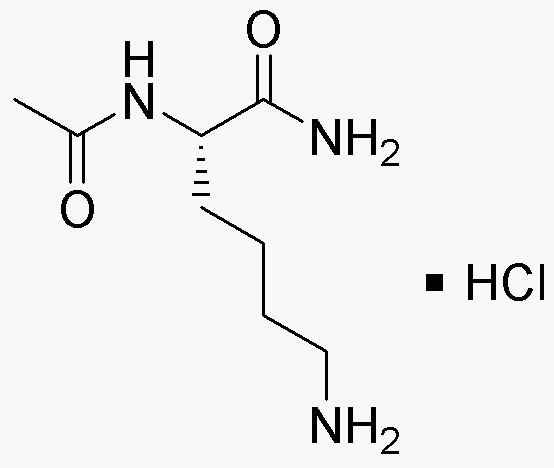Na-Acetyl-L-lysine amide hydrochloride is widely utilized in research focused on
- Biotechnology: This compound serves as a key ingredient in cell culture media, promoting cell growth and enhancing protein expression in biopharmaceutical production.
- Nutrition: It is used as a dietary supplement to support muscle recovery and overall health, particularly beneficial for athletes and individuals engaged in intense physical activities.
- Pharmaceuticals: The compound is explored for its potential therapeutic effects in treating metabolic disorders due to its role in amino acid metabolism.
- Cosmetics: Its moisturizing properties make it a valuable addition to skincare formulations, helping to improve skin hydration and elasticity.
- Research and Development: It is utilized in various studies to understand the biochemical pathways involving amino acids, aiding researchers in developing new treatments and therapies.
General Information
Properties
Safety and Regulations
Applications
Na-Acetyl-L-lysine amide hydrochloride is widely utilized in research focused on
- Biotechnology: This compound serves as a key ingredient in cell culture media, promoting cell growth and enhancing protein expression in biopharmaceutical production.
- Nutrition: It is used as a dietary supplement to support muscle recovery and overall health, particularly beneficial for athletes and individuals engaged in intense physical activities.
- Pharmaceuticals: The compound is explored for its potential therapeutic effects in treating metabolic disorders due to its role in amino acid metabolism.
- Cosmetics: Its moisturizing properties make it a valuable addition to skincare formulations, helping to improve skin hydration and elasticity.
- Research and Development: It is utilized in various studies to understand the biochemical pathways involving amino acids, aiding researchers in developing new treatments and therapies.
Documents
Safety Data Sheets (SDS)
The SDS provides comprehensive safety information on handling, storage, and disposal of the product.
Product Specification (PS)
The PS provides a comprehensive breakdown of the product’s properties, including chemical composition, physical state, purity, and storage requirements. It also details acceptable quality ranges and the product's intended applications.
Certificates of Analysis (COA)
Search for Certificates of Analysis (COA) by entering the products Lot Number. Lot and Batch Numbers can be found on a product’s label following the words ‘Lot’ or ‘Batch’.
*Catalog Number
*Lot Number
Certificates Of Origin (COO)
This COO confirms the country where the product was manufactured, and also details the materials and components used in it and whether it is derived from natural, synthetic, or other specific sources. This certificate may be required for customs, trade, and regulatory compliance.
*Catalog Number
*Lot Number
Safety Data Sheets (SDS)
The SDS provides comprehensive safety information on handling, storage, and disposal of the product.
DownloadProduct Specification (PS)
The PS provides a comprehensive breakdown of the product’s properties, including chemical composition, physical state, purity, and storage requirements. It also details acceptable quality ranges and the product's intended applications.
DownloadCertificates of Analysis (COA)
Search for Certificates of Analysis (COA) by entering the products Lot Number. Lot and Batch Numbers can be found on a product’s label following the words ‘Lot’ or ‘Batch’.
*Catalog Number
*Lot Number
Certificates Of Origin (COO)
This COO confirms the country where the product was manufactured, and also details the materials and components used in it and whether it is derived from natural, synthetic, or other specific sources. This certificate may be required for customs, trade, and regulatory compliance.


